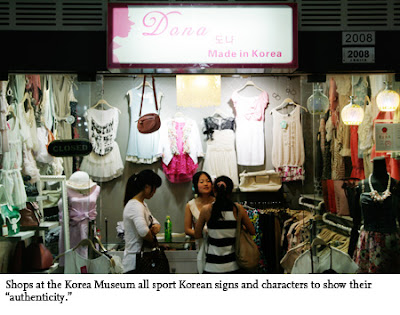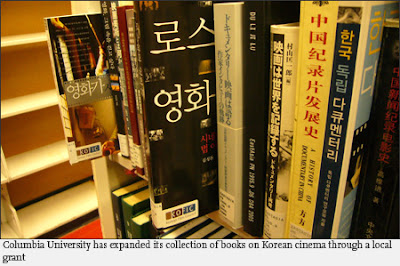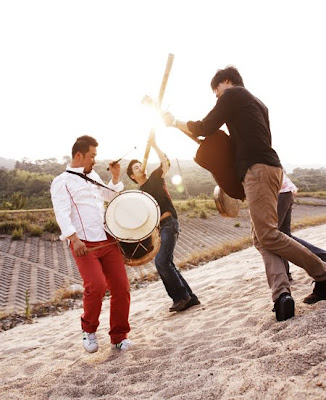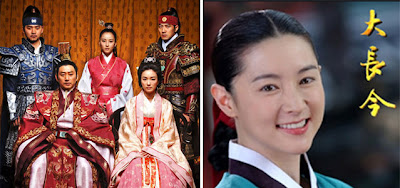
Foreign students experience a day in the life of a Confucian scholar at Sungkyunkwan University.(Photo:Korea Magazine July 2011)
In particular, the number of Chinese students has risen every year, accounting for more than half of all foreign students in Korea. China has been sending an increasing number of students overseas because of its recent economic growth and tuition here is relatively lower than in Japan or the United States. There are now more than 400 technical colleges, universities and graduate schools in Korea operating a wide range of programs for foreign students. They offer student exchanges, seasonal semesters, English only classes and Korean language courses. Most universities even offer scholarships for students from abroad, which will cover 30% to 100% of tuition costs, depending on the student’s grades.
100,000 by 2012
In 2008, the Korean government set a goal to bring in 100,000 international students by 2012, in an effort to attract talented individuals to the country. To help reach their projected number, the Global Korea Scholarship(GKS) program was created in 2009 to offer support to foreign students studying here.
One of the roles of GKS is to select foreign students for government scholarships, in which a year of Korean language courses, degree courses, airplane tickets, living costs, research funds, tuition costs and healthcare are provided for. In addition, GKS runs a variety of short-term scholarship programs, assisting exchange students and financially-independent students. In 2011, a total of 400 students (100 undergraduates and 300 graduates), were chosen for the GKS scholarship on the recommendation of embassies and universities.

Students discuss life in Korea(L). Students attend a lecture at the University of Ulsan (R). (Photo:Korea Magazine July 2011)
The Korean government is also supporting universities in their quest to attract more students from abroad by establishing new programs for the best and the brightest. The Korean government awards certification to schools that meet certain criteria, offering a number of incentives that will allocate funds to foreign students studying here.
Foreigners who want to study in Korea are currently required to reach level three or above on the TOPIK (Test of Proficiency in Korean) and level four before graduation for college-level students. The National Institute for International Education runs a free Korean language learning website, KOSNET, in four languages (English, Japanese, Chinese and Spanish) to help foreigners learn Korean.
[University initiatives]
Local universities are actively competing to attract the most international students possible, as a diverse student body encourages cultural exchange in an era of globalization.
Kyung Hee University has one of the highest concentrations of foreign students, with 2,585 students from 69 countries enrolled in the first semester of 2011. Of them, 1,916 are undergraduates, 480 are masters students, 71 are in integrated courses and 118 are in doctoral courses. Kyung Hee waives entrance fees for the top 10% of foreign applicants who pass the entrance exam, and finances the students’ tuition if they reach a TOPIK level six and maintain a GPA of at least 3.7. Those with a GPA of at least 3.3 are offered opportunities to participate in overseas internships and educational programs, with all expenses paid for by the school.

International students participate in a hands-on pottery event at Hanyang University during an activity day (L). A student tries his hand at a traditional activity at Hanyang University during a school-wide event (R). (Photo:Korea Magazine July 2011)
Kyung Hee University has foreign student centers have been established to form a sense of community and to provide extracurricular programs for further studying. Departments also have assistants to manage issues related to foreign students and freshmen taking Korean language courses. Regular classes consist of four semesters over a period of 10 weeks, with students designated to the right level through a placement test.
The university established a one-on-one mentoring system in 1996, where Korean and foreign students can partner up to have direct, conversational exchanges on a daily basis. There are four foreign student dormitories that can accommodate up to 320 people, and online counseling sites in five languages (English, Japanese, Chinese, Mongolian and Russian) to help foreigners communicate with administrative staff. Winter sports events are held every semester, creating a tight-knit community within a comfortable setting.

2011 Korean Cultural Festival at Korea University. (Photo: Yonhap News)
Hanyang University grants more than 3 billion won in scholarships to international students, and 240 science majors in the masters and doctoral courses are given a 50% tuition discount to promote the science and technology departments. The school saw 1,740 foreign students enroll in the first semester of 2011, and also operates a counseling center for foreign students, providing mentors, advice on cultural issues and opportunities to
connect with local students. The Hanyang International Volunteer Association also helps new students get adjusted socially, from the time they enter the school until they find a job post-graduation.
Korea University, one of the nation‘s top schools, is one of the five Korean members of the International Student Exchange Program (ISEP). Last March, it established the International One Stop Service Center, which offers programs and services to help foreign students adapt to their surroundings. The center helped increase the foreign student body to 2,074 last year, which then led to the creation of additional services in English, Chinese and Japanese. Now, students can access counseling, job information services, emergency hotlines, post-graduate networks, news about the student council and language exchange partners through the center.
Source: Korea.net


































